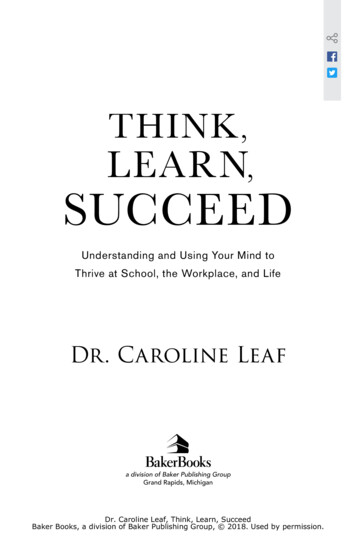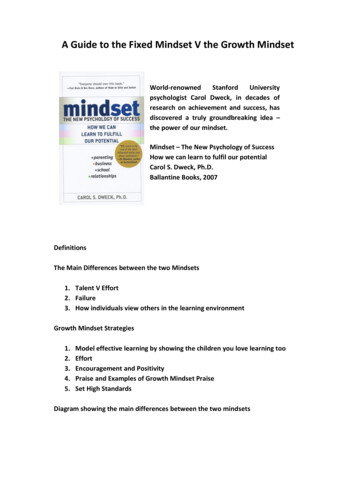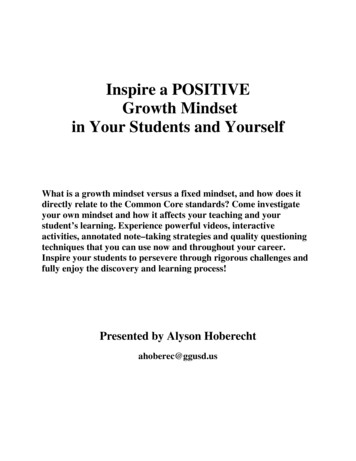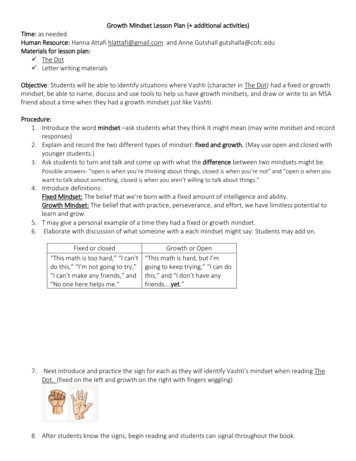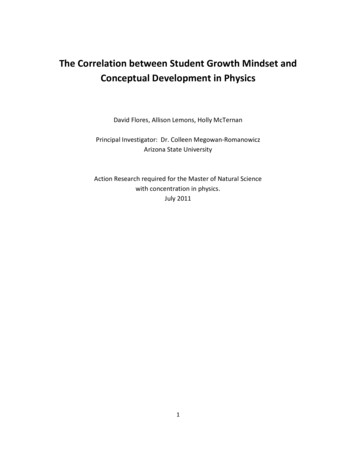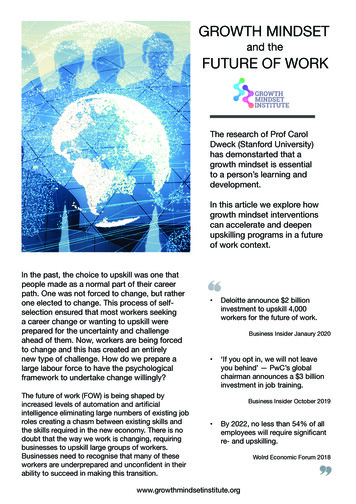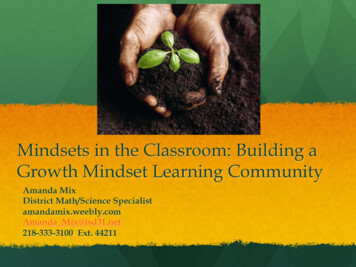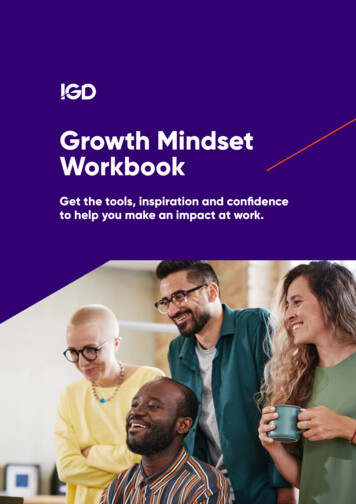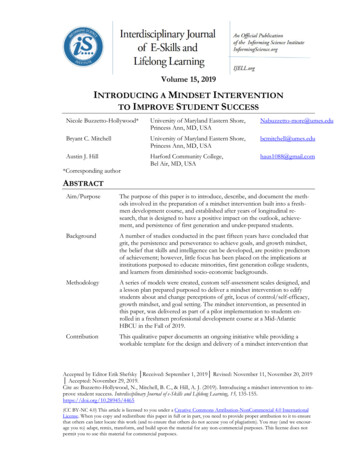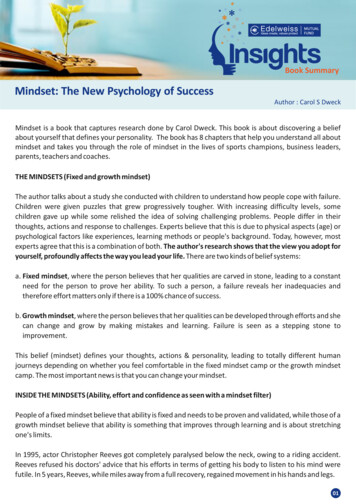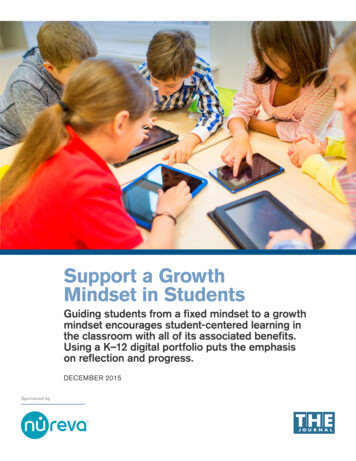
Transcription
Support a GrowthMindset in StudentsGuiding students from a fixed mindset to a growthmindset encourages student-centered learning inthe classroom with all of its associated benefits.Using a K–12 digital portfolio puts the emphasison reflection and progress.DECEMBER 2015Sponsored by
Table of ContentsIn many schools, the teacher-centered classroom has become an anachronism. AsIntroduction . . . . . . . . . . . . . . . . . . . . . . . . . . . . . . 2individual can fully address the needs of an entire group of students. Every student learnsGrowth mindset vs. fixed mindset . . . . . . . . . . . 2differently and comes to the class with distinct abilities and interests.The essential role played by thedigital portfolio . . . . . . . . . . . . . . . . . . . . . . . . . . . . 3The impact of reflection . . . . . . . . . . . . . . . . . . . . 4Pursuing growth mindset and reflectionat any age . . . . . . . . . . . . . . . . . . . . . . . . . . . . . . . . 4The cumulative value of thedigital portfolio . . . . . . . . . . . . . . . . . . . . . . . . . . . . 5innovators have learned, the era of the “sage on the stage” has passed. No singleThe alternative – student-centered learning – helps students “understand themselves ashaving agency and choice.” Armed with that idea, students “begin to own their learningand are more motivated and engaged.” 1When students can see the relevance of the tasks they’re undertaking, explain educationresearchers Douglas Fisher and Nancy Frey, they go about the work with “a belief thattheir efforts will bear fruit” and are likely to be more motivated. 2Beginning the growth mindset journey . . . . . . . 6About Nureva . . . . . . . . . . . . . . . . . . . . . . . . . . . . . 7However, shifting from instructional practice founded on the idea that the teacher ownsAbout THE Journal . . . . . . . . . . . . . . . . . . . . . . . . . 7responsibility for student learning to an approach in which students are co-designers oftheir education isn’t easy. One good place to start this work is by focusing on studentmindset. Students must see themselves as being capable of learning – a perspectivethat requires a “growth mindset.”A recent survey by THE Journal magazine found that nearly 100 percent of K–12educators considered student ownership of learning either “important” or “veryimportant.” 3 Growth mindset paired with using a digital portfolio helps studentsrecognize their own capacity to learn by allowing them to see their progress over time.Growth mindset vs. fixed mindsetThe concept of the growth mindset grew out of research conducted by Carol Dweck.A psychology professor at Stanford University, Dweck came to the forefront with thepublication of her now-classic book, Mindset: The New Psychology of Success. Her workSurvey MethodologyIn the summer of 2015, THE Journal soughtfeedback from its national readership to gauge“bridges developmental psychology, social psychology and personality psychology andexamines the mindsets people use to understand themselves and guide their behavior.” 4As Dweck explains in a 10-minute TED video that has been viewed 3.4 million times, studentsthe level of understanding among educatorsmay come at their work with either a “fixed mindset” or a “growth mindset.” The first isabout the precepts and practices of the growthcharacterized by a belief that intelligence is a fixed trait or set in concrete. When students failmindset and using digital portfolios to supportin solving problems, their intelligence has been called into question and they’ve been judged aits development. The survey was completed byfailure. With a fixed mindset, the children “run from error; they don’t engage with it.”466 people. Administrative leaders (36 percent)and teaching staff (36 percent) made up thelargest groups of respondents. The remainderconsisted of IT management and educationA growth mindset, on the other hand, sets the students’ brain “on fire.” They believe theycan improve and learn from failure. They persist in correcting themselves. 5staff (7 percent), nonteaching staff (4 percent)and “other,” those primarily affiliated withschools in some capacity (17 percent). Nearlyhalf (45 percent) of the respondents workedin schools or districts with fewer than 2,500students. Another 27 percent were in schoolsor districts with 2,500 to 14,999 students.Schools with 15,000 students and higher madeup 28 percent.1Patrick, Susan and Chris Sturgis. “Maximizing Competency Education and Blended Learning: Insights fromExperts.” CompetencyWorks. March 2015. ation-and-Blended-Learning.pdf.2Fisher, Douglas and Nancy Frey. “Choice Words.” National Association of Secondary School Principals.December 2012. c Instructional Leader 1212.3THE Journal. “Digital Portfolios Survey.” September 2015.4Dweck, Carol. Stanford University. https://psychology.stanford.edu/cdweck.5TED. “Carol Dweck.” December 2014. https://www.ted.com/speakers/carol dweck.2
The inner voice of a fixed mindset vs. a growth mindsetPromoting a growthmindset can “helpstudents own theirwork, includingmistakes.”– retired teacher and survey participantThe fixed mindset saysThe growth mindset saysWhen facing a challenge“I may not have the innate ability forthis.”“If I fail at this, I can learn from thefailure and try again.”When facing a setback“No surprise there. I could have donethis if I had the right abilities.”“Practice makes perfect. That’s what Ineed to do.”When facing criticism“That one’s not my fault. I wasn’t theright person to tackle the job.”“Give me a chance to fix this and learnfrom the experience.”Educators identify numerous benefits when a student develops a growth mindset.According to the THE Journal survey A growth mindset helps students embrace challenges and learn from failure(72 percent) Developing a growth mindset helps students to become lifelong learners (70 percent) A growth mindset encourages students to learn from their mistakes (69 percent) Students with a growth mindset see effort as necessary to develop skills (66 percent) S tudents with a growth mindset are better able to use constructive criticism to growand learn (64 percent)Promoting a growth mindset, says one retired teacher, can “help students own theirwork, including mistakes.” 6The essential role played by the digital portfolioDigital portfolios give students an effective way to monitor the results of their learningefforts. Nearly 8 in 10 educators (79 percent) believe a digital portfolio serves two vitalfunctions in this approach to learning:1) It helps students gain insight into personal growth over time2) It helps students focus on process and progressThe digital portfolio lends additional value in the classroom in other ways as well.According to survey results, a digital portfolio may Help teachers gain insight into growth over time (75 percent) Encourage students to adopt a growth mindset (61 percent) Facilitate communication with parents (65.5 percent) 7That last benefit shouldn’t be underappreciated. As one instructionaltechnology facilitator observed in the survey results, a digital portfolio helpsCourtesy of Shutterstockparents “see student challenges, strengths and progress.” 86THE Journal.7Ibid.8Ibid.3
What is adigital portfolio?Nearly three-quarters of respondents (73 percent) also emphasize digital portfoliosA digital portfolio helps students save digitaldigital portfolio, explains an assistant special programs director, “Students can see notversions of their work, as well as observationsonly how they have progressed, but how far they still need to go [to] gain new goals.”help students by promoting “goal setting.” The importance of goal setting to studentdevelopment was cited by almost 100 percent of educators. By tracking goals through aand feedback they make themselves andreceive from others. This promotes studentThe continual appraisal of goals and progress helps students “see growth and buildreflection and helps them focus on theirconfidence in planning for future growth,” notes a teacher in advanced placement andprogress as well as the learning processitself. It also serves as a repository for thebest work, which they can share with peers,teachers, parents, postsecondary institutionssocial studies. 9 Those are both critical aspects of the growth mindset.The impact of reflectionand potential employers. Content within aThe number one benefit of using digital portfolios, as cited by almost 9 in 10 educators,digital portfolio can be linked to other placesis the technology helps students reflect on their work,10 which education expertsin the portfolio and to external web pages orconsider a central aspect of learning. “Teachers who promote reflective classroomsother content. The portfolio is also scalableensure that students are fully engaged in the process of making meaning,” report Arthurin that it can grow in both breadth and depthover time, thus encouraging lifelong learning.As one high school librarian explained, “For thestudents, [the digital portfolio] empowers theirCosta and Bena Kallick in their book, Learning and Leading with Habits of Mind. 11Reflection provides a way to think about learning and helps learners “understand what,ownership in what they’re learning and howhow and why they learn. It is about developing the capacity to make judgments andthey’re learning. And it also empowers them toevaluating where learning might take you,” says Karen Hinett, an education developer atorder the way they approach information.”the UK Centre for Legal Education. 12Pursuing growth mindset and reflection at any ageEducators see no reason not to begin work on establishing a growth mindset and thepractice of reflection as early as possible, according to 85 percent of respondents.Certainly, conversations and activities will be different depending on the student gradelevel. In kindergarten, say Costa and Kallick, reflection could mean a student describingwhat has been drawn and commenting on its realism and use of color or letters. Bysecond grade, the focus may be on details and idea development. In third or fourthgrade, students might comment that they would “proofread” or “stay to the subject.” 13Given the link between using digital portfolios and their power to encourage studentsto reflect on their work, should the youngest learners use digital portfolios as well? Thesurvey results suggest educators are fairly confident they can. While 17percent of respondents said a digital portfolio should wait until the student9THE Journal.10Ibid.Courtesy of Shutterstock11Costa, Arthur and Bena Kallick. “Chapter 12. Learning Through Reflection.” Learningand Leading with Habits of Mind. December 2008. ters/Learning-Through-Reflection.aspx.12Hinett, Karen. “Improving learning through reflection – part one.” The Higher EducationAcademy. November 2004. od resource/content/3/id485 improving learning part one.pdf.13THE Journal.4
is in middle school, a solid three-quarters said it could be introduced in elementary“Teachers lay thegroundwork in simpleways when children areyoung. Then by the timechildren reach thoseolder grades, thepractices are embeddedinto their habits oflearning.”school or earlier. 14The technology company Nureva has seen the effectiveness of introducing adigital portfolio into K–12 classes. Young children create a bridge or building out ofmarshmallows and toothpicks and then take photos of their work with a tablet to postto their digital portfolios. Kindergartners work with an older “buddy” to record video oraudio files expressing what they’re learning and upload those to the digital portfolio.Parents and teachers can comment on the work they see in the digital portfolio, whichstudents can read or have read to them.Teachers lay the groundwork in simple ways when children are young. Then by thetime children reach those older grades, the practices are embedded into their habitsof learning. While much of early childhood development currently focuses on literacy,reading and math, educators see the value of acquainting students with these othertools that will prove highly beneficial in the long run.The cumulative value of the digital portfolioThe real impact of a digital portfolio grows year over year. As educators report, long-termuse of digital portfolios helps students gain perspective in how they have grown andprogressed (90 percent) and better reflect on how they have overcome past challenges(70 percent). As one district administrator points out, the use of the digital portfolio can“remove the feeling of failure if a student does not have a great performance on highstakes testing. They know they have worked [and] grown and have evidence of it.” 15Also, as students move from one grade to the next, the digital portfolio helps new teachersgain a better understanding of the students’ interests and passions inside and outside ofthe classroom (74 percent), as well as their challenges and strengths (70 percent). 16To attain the deep benefits of a digital portfolio, the appropriate technology choice isimportant. While a portion of respondents report they could use blogs, image galleries andonline productivity applications for this purpose, these solutions have to be “jury-rigged” towork. Half of educators recognized the value of using a dedicated digital portfolio. 17The best of these solutions for K–12 help students: Easily upload evidence of their learning themselves, no matter the age Reflect on their work themselves and with others Receive feedback on their progressCourtesy of Shutterstock Showcase achievements over time to a select but broad audience14THE Journal.15Ibid.16Ibid.17Ibid.5
S ave content as a continuous learning journey over time,from grade to grade F oster goal setting and reflection with tools designedspecifically to deepen student learning A ccess content from anywhere, including mobiledevices A ccess their work any time, even after graduation oracross schools and districts 18Teachers and administrators also recognize the importanceof ensuring digital portfolio technology helps educatorssupport their project-based and competency-basedNureva Troove digitalportfolio software:a purpose-built digitalportfolio for K–12Nureva Troove software is a cloud-based digitalpractices (71 percent and 57 percent, respectively). 19However, to make sure the digital portfolio always remains student-directed, leadingprograms feature two “faces.” One is teacher-directed and more academic and the otheris student-directed and more personal. Students should be able to toggle between them.Beginning the growth mindset journeyportfolio that enables students to save digitalPractitioners report that one obstacle to bringing about a growth mindset attitude inversions of their academic and personal work,the classroom is the students themselves. They may question why they need to be inalong with feedback from peers and teachers.charge of their own learning. A “first step” in helping students adjust to learner-centeredNureva was founded in 2014 by David Martin andinstruction in the classroom will be “to explain why this approach is the best possibleNancy Knowlton, the same technology veteranswho introduced another educator favorite: theSMART Board interactive whiteboard, in 1991.To learn more, visit http://www.nureva.com/.way to enhance their academic success.” 20Then what happens? Through the THE Journal survey, educators offer a number of waysto help students understand the need to develop a growth mindset: Frame assignment goals to support a growth mindset (69 percent) Praise students for hard work instead of fixed intelligence (64 percent) Incorporate lessons that directly teach a growth mindset (62 percent) Read and tell stories that illustrate the power of hard work (54 percent) Teach students how their brains work (51.5 percent) 2118THE Journal.19Ibid.20National Education Association. “A Clear Rationale for Learner-Centered Teaching.” October 2008.http://www.nea.org/home/34221.htm.21THE Journal.6
Instilling a growth mindset is vital. It sets up a child to fulfill all thecapabilities every educator wants to see in each student: Self-motivated learning Enthusiasm for the next challenge A view that mistakes are temporary setbacks to be overcomeCourtesy of Shutterstock An ability to accept feedback and criticism Perseverance Continual questioning A risk-taking mentality 22The journey starts by helping students understand that their intelligence can grow withpractice. Reflection and goal setting are aspects of the process. A digital portfolio is theoptimal tool for supporting the growth mindset by helping students track their progressand gain insight into how they learn best.22THE Journal.About NurevaNureva Inc. develops education solutions that foster a joy for learning. The companyfocuses on delighting customers with simple, thoughtful hardware, software andservices. A passion for deep customer understanding and a commitment to innovationdrive the company’s product road map.For more information, visit http://www.nureva.com.Nureva1000, 1221 8 Street SWCalgary, ABT2R 0L4Canada 2015 Nureva Inc. All rights reserved. Nureva, Troove,the Nureva logo and the Troove logo are trademarksof Nureva Inc. in the United States, Canada andother countries. All third-party product and companynames are for identification purposes only and may betrademarks of their respective owners.About THE JournalTHE Journal is dedicated to informing and educating K-12 senior-level district andschool administrators, technologists, and tech-savvy educators within districts, schools,and classrooms to improve and advance the learning process through the use oftechnology. Launched in 1972, THE Journal was the first magazine to cover educationtechnology.THE Journal’s franchise consists of a digital format magazine, the web sitethejournal.com, six newsletters (THE News Update, THE Journal Insider, IT Trends,THE SmartClassroom, and School Security), and targeted list rental opportunities.With a distribution of 100,000 circulation, THE Journal is the leading resource foradministrative, technical, and academic technology leaders in K-12 education.9201 Oakdale Ave.Suite 101Chatsworth, CA 91311To learn more, visit www.thejournal.com.(818) 814-52777
The inner voice of a fixed mindset vs. a growth mindset The fixed mindset says The growth mindset says When facing a challenge "I may not have the innate ability for this." "If I fail at this, I can learn from the failure and try again." When facing a setback "No surprise there. I could have done this if I had the right abilities."
